Parks & Reserves in Tanzania
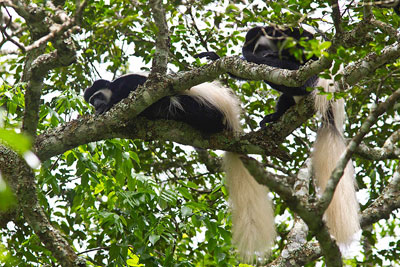
Arusha National Park
The Park has a total area of 137 sq km. And are over 50 km of game viewing road/track in the Ngurdoto and Momella Section of the Park. The Major attractions of this park include the Momella Lakes, Ngurdoto Crater, Meru Crater, cone as well as the rare black and white Colombus Monkey. Many northern bird migrants can be seen between May and October.
GombeNational Park
The park lies about 16Km. north of Kigoma in the north-west part of Tanzania. It is the smallest park in Tanzania with only 52 sq km.
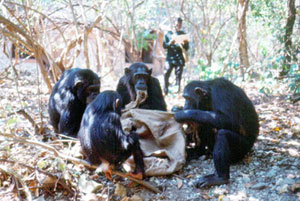
The Gombe stream national Park remains one of the few areas in Africa which harbours one of the most rare species of animals - Chimpanzee. Apart from Mahale Mountains, South kigoma, there is no where else in tanzania where Chimpanzee can be observed in the wild.
Lake Manyara National Park
Lake Manyara, one of Tanzania's smallest and most diverse national parks, bordered by the dramatic Western Escarpment of the Great Rift Valley, Lake Manyara is notable for its abundant birdlife, diverse vegetation, tree-climbing lions, and hippos among others. Lake Manyara is a scenic gem, with a setting extolled by Ernest Hemingway as “the loveliest I had seen in Africa”. Located on the way to Ngorongoro Crater and the Serengeti, Lake Manyara National Park is well worth a stop in its own right. Lake Manyara covers an area of 127 sq miles, of which up to 77 Sq miles is lake when water levels are high.
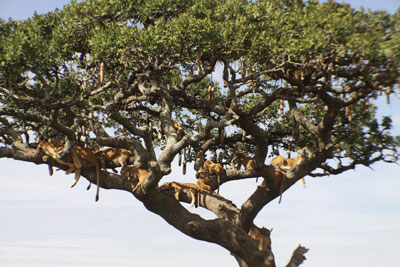
The compact game-viewing circuit through Manyara offers a virtual microcosm of the Tanzanian safari experience. Its ground water forests, bush plains, baobab strewn cliffs, and algae-streaked hot springs offer incredible ecological variety in a small area, rich in wildlife and incredible numbers of birds.
Manyara provides the perfect introduction to Tanzania’s birdlife. More than 400 species have been recorded, and even a first-time visitor to Africa might reasonably expect to observe 100 of these in one day. Highlights include thousands of pink-hued flamingos on their perpetual migration, as well as other large water birds such as pelicans, cormorants and storks. Even reluctant bird-watchers will find something to watch and marvel at within the national park.
Contrasting with the intimacy of the forest is the grassy floodplain and its expansive views eastward, across the alkaline lake, to the jagged blue volcanic peaks that rise from the endless Maasai Steppes. Large buffalo, wildebeest and zebra herds congregate on these grassy plains, as do giraffes – some so dark in coloration that they appear to be black from a distance.
Lake Manyara’s famous legendary tree-climbing lions are another reason to pay this park a visit. The only kind of their species in the world, they make the ancient mahogany and elegant acacias their home during the rainy season, and are a well-known but rather rare feature of the northern park. In addition to the lions, the national park is also home to the largest concentration of baboons anywhere in the world -- a fact that makes for interesting game viewing of large families of the primates.
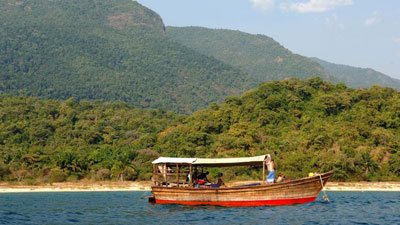
Mahale Mountains National Park
Mahale Mountain National Park is home to chimpanzees, located in Western Tanzania, bordering Africa's longest and deepest, Lake Tanganyika and covers an area of 623 miles. While not as well known as Jane Goodall's Gombe River Stream Park, Mahale is preferred because there are fewer human visitors.
Mahale Mountains, like its northerly neighbour Gombe Stream, is home to some of Africa’s last remaining wild chimpanzees: a population of roughly 800, habituated to human visitors by a Japanese research project founded in the 1965. Tracking the chimps of Mahale is a magical experience.
The area is also known as Nkungwe, after the park's largest mountain, held sacred by the local Tongwe people and at 8,069 ft the highest of the six prominent points that make up the Mahale Range.
And while chimpanzees are the star attraction, the slopes support a diverse forest fauna, including readily observed troops of red colobus, red-tailed and blue monkeys, and a kaleidoscopic array of colourful forest birds.
Mt. Kilimanjaro National Park
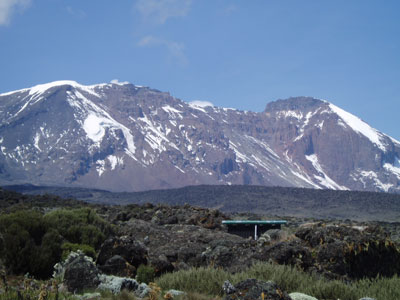
Lying only 3 degrees south of the Equator and at an altitude of 5895 meters above sea level. "As wide as all the world, great, high and unbelievable white in the sun, was square top of Mt. Kilimanjaro", so wrote Ernest Hemingway. Mt. Kilimanjaro is the highest mountain in Africa, the highest free standing mountain in the world, and one of the largest volcanoes ever to burst through the earth's crusts. The base of this immense mountain measure 50 x 80 km and the outstanding features are the three major volcanic centers, Shira in the west (4260 m), Mawenzi in the East (5260 m) and the snow capped Kibo is the middle (5895 m).
Apart from its dramatic geological features and the beautiful montane vegetation, Mount Kilimanjaro is also notable for its bird life, which is plentiful in the rich forest zone. There is also a wide array of butterflies, moths and other insects. The mountain can be climbed anytime of the year although it is often wet in the forest during the rainy season in April and May. The best period is from August to November.
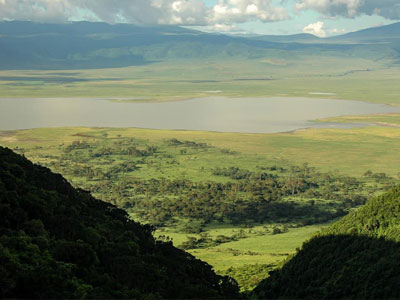
Ngorongoro Conservation Area
The Ngorongoro Conservation Area is situated some 118 miles west of Arusha, between Lake Manyara and Serengeti National Parks. Covering approximately 3,200 square miles, the Ngorongoro Conservation Area consists of the Ngorongoro Crater itself, the Olduvai Gorge, the Empakai crater and the Oldonyo Lengai Mountain. The Ngorongoro Conservation Area is a pioneering experiment in multi-purpose land use where the diverse interests of wild animals, plants and people are being integrated. Wild animals are protected as in the National parks. The craters of Ngorongoro and Empakai are reserved exclusively for wildlife, while the rest of the Conservation Area is shared by wildlife, people and livestock.
Ngorongoro was once a gigantic volcano, perhaps taller than Kilimanjaro. Today, its peak collapsed into a caldera, it is an extensive highland area with the spectacular 600m deep crater as its focal point. Apart from being one of Africa’s scenic wonders, and having approachable wildlife that it’s sometimes derogatorily labeled a ‘zoo’, Ngorongoro has diverse habitats and micro-climates. The rim is at an altitude of 7,500 feet, so be prepared for cool temperatures and clouds that roll over the rim like a waterfall in slow motion.
About 2.5 million years ago the young Ngorongoro Volcano became filled with molten rock that subsequently solidified into a crust or roof. As lava chamber emptied, the solid domed collapsed and thus was formed the largest perfect caldera in the world that has its wall intact (12 miles wide, 610-760 deep and covering 102 sq miles). The Ngorongoro Crater is a UNESCO protected “World Heritage Site” and one of Africa’s best- known wildlife arenas. The sight of the Ngorongoro Crater is simply stunning. “There is nothing with which to compare. It is one of the wonders of the world…” once wrote Professor Bernard Grzimek. An utterly unique International biosphere reserve, the crater harbors grasslands, swamps, forests, saltpans, a fresh water lake and glorious variety of birdlife, all enclosed within its towering walls. In addition to the Big Five the crater hosts up to 30,000 large mammals. Most are grazers, of which wildebeest and zebra comprise almost half, the rest warthog, gazelle, eland, kongoni etc. As a result of these extraordinarily large numbers of herbivores, the crater also numbers one of the densest predators’ populations in Africa, most of which are lion, cheetah and hyena.
And if the mix of big game and birdlife hasn’t made you giggle yet, head to the freshwater pools in the crater where you’ll see a range of a cranes and ducks, including migratory garganey and European shoveller, squeezed in among the abundant hippos.
Ruaha National Park
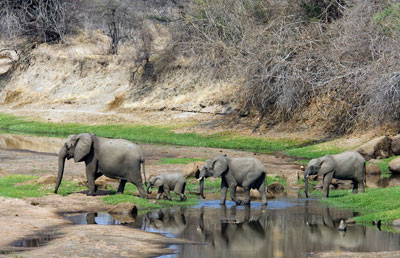
Ruaha preserves yet another massive chunk of raw African wilderness. Remote and far from regular safari routes, this hauntingly beautiful woodland park teams with game.
It's name is derived from the great Ruaha River. Flowing across it's entire eastern border, the river is a scenic delight and a magnet for wildlife in staggering numbers, Elephants reign supreme. Hippos en massae are guarantee. Kudu, eland, giraffe and dik dik thrive in abundance. The predators, of course, are never far behind. Ruaha on the wing, is no less spectacular. Flocks of water and woodland birds display in brilliant profusion. Rich with game, but few tourists, Ruaha;s rugged bush is Tanzania's best kept secret.
Selous Game Reserve
Located in south-east Tanzania in a remote and little-visited part of the country, the Selous Game Reserve is Africa’s largest protected wildlife reserve and covers more than 5% of Tanzania’s total area. Selous Game Reserve covers an area of 33,926 sq miles. Its home to roaming elephant populations, the area’s famous wild dogs, and some of the last black rhino left in the region.
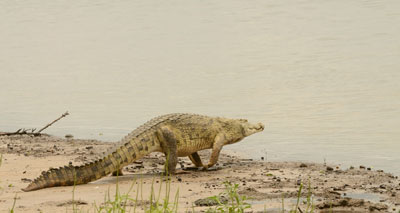
Due to its remote location, and because it is most easily accessible only by small aircraft, the Selous Game Reserve has remained one of the untouched gems of Tanzania’s national parks and game reserves, and offers visitors a chance to see a wild and expansive Africa far from tarmac roads and gift shops.
Selous Game Reserve was named after Frederick Courteney Selous, a British explorer and hunter in East Africa who wrote a book about the region and his travels, and was tragically killed in land now named after him during the First World War. In 1905, when few people in East Africa thought of land conservation and the preservation of wildlife for posterity, portions of the area were earmarked for a hunting reserve. In 1922, the land area was increased and named after Frederick Selous. From then until 1975, when the current boundaries were delineated, the Selous Game Reserve increased steadily in allocated land.
These days, tourists flock to the north of the reserve, while large portions of the south are still reserved for hunting. The Rufiji River Delta is a striking feature of the game reserve. It connects the Great Ruaha River with the Rufiji River and not far from the park boundaries empties out into the Indian Ocean along the Tanzanian Coast.
The Rufiji River is the largest water catchment locations in the region, and as such, is home to a plethora of varied water and bird life. Along its shores, oppulent hippos sleep languidly in the mud and sun themselves, mouths wide open, as the river passes by. Crocodiles are also common along the Rufiji’s riverbanks, their armour plated skins the only rough edges in the rivers incessant flow. Stiggler’s Gorge, where the Great Ruaha River meets the Rufiji River, is a breathtaking example of the diversity and spectacular scenery along the game reserve's waterways.
The Selous is unique among Tanzania’s more renowned preserved areas because it is a game reserve, not a national park, and therefore a larger range of activities are permitted. Boating safaris are becoming a popular alternative to vehicle-based trips, and offer visitors a chance to see the diverse life along the Rufigi River up close in all its splendour. Hiking safaris and fly camping are also ideal ways to explore the country and add a bit of adventure to your African experience.
Serengeti National Park
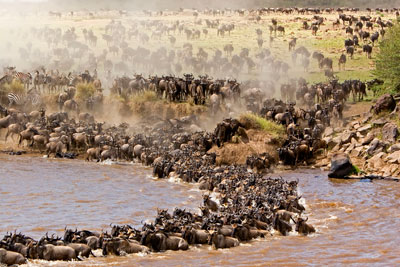
Serengeti National Park is undoubtedly the best – known wildlife sanctuary in the world, unequaled for its natural beauty and scientific value. Serengeti National Park has area of 5,700 sq miles, is as Northern Ireland, which includes the Ngorongoro Conservation Area, the Maswa Game Reserve and the Maasai Mara Game Reserve (in Kenya), is roughly the size of Kuwait. It lies between the shore of Lake Victoria in the west, Lake Eyasi in the south, and the Great Rift Valley to the east. As such, it offers the most complex and least disturbed ecosystem on earth.
The name Serengeti derived from the Maasai language it means endless plains, these vast plains are the origins of the greatest wildlife spectacle on earth, the migration of over a million wildebeest to the Maasai Mara plains in Kenya. Pursued by hungry predators, this becomes a struggle of life and death that only the Serengeti and Maasai Mara are honoured to host.
A unique combination of diverse habitats enables it to support more than 30 species of large herbivores and nearly 500 species of birds. Its landscape, originally formed by volcanic activity, has been sculptured by the concerted action of wind, rain and sun. It varies from open grass plains in the south, savannah in the north, to extensive woodland and black clay plains to the west. Small rivers, lakes and swamps are scattered throughout and the rock outcrops called kopjes. In the south- east rise the great volcanic massifs and craters of the Ngorongoro Highlands. Each area has its own particular atmosphere and wildlife.
When drought sets in, Serengeti is the site of one of the most breathtaking events in the animal kingdom - the migration of thousands of wildebeest heading southwest, north or west in search of water and greener pastures, a million wildebeest... each one driven by the same ancient rhythm, fulfilling its instinctive role in the inescapable cycle of life: a frenzied three-week bout of territorial conquests and mating; survival of the fittest as 25 miles long columns plunge through crocodile-infested waters on the annual exodus north; replenishing the species in a brief population explosion that produces more than 8,000 calves daily before the 600 miles pilgrimage begins again.
Yet even when the migration is quiet, the Serengeti offers arguably the most scintillating game-viewing in Africa: great herds of buffalo, herds of elephant and giraffe, and thousands upon thousands of eland, topi, kongoni, impala and Grant’s gazelle and African great predators; lion, leopard and cheetah. Almost uniquely, all three African jackal species occur here, alongside the spotted hyena and a host of more elusive small predators, ranging from the insectivorous aardwolf to the beautiful serval cat. And even small mammals such as Gaudy agama lizards and rock hyraxes scuffle around the surfaces of the park’s isolated granite koppies.
The Serengeti’s climate is usually warm and dry. The main rainy season is from March to May, with short rains falling from October to November. The amount of rainfall increases from about 508 mm on the plains in the lee of Ngorongoro Highlands to about 1,200 mm on the shores of Lake Victoria. All is lush and green after the rains, but gradual drying up follows which restricts plants growth and encourages animals to migrate in search of permanent waters. With altitudes ranging from 920 to 1,820 metres, mean temperatures vary from 15 degrees to 25 degrees Celsius
The Serengeti was made a partial Game Reserve in 1921 and a full one in 1929. It was expanded and upgraded to a National Park in 1951.
Tarangire National Park
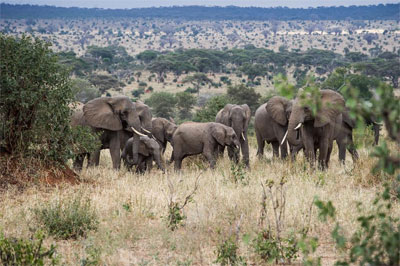
Tarangire National Park is Located 75 miles southwest of Arusha, this park is second only to Ngorongoro crater in its concentration of wildlife during the dry season, with the highest population density of elephants anywhere in Tanzania, and its sparse vegetation, strewn with baobab and acacia trees, makes it a beautiful and special location. Tarangire National Park has an area of 1,560 sq miles.
Herds of up to 300 elephants scratch the dry river bed for underground streams, while migratory wildebeest, zebra, buffalo, impala, gazelle, hartebeest and eland crowd the shrinking lagoons. It's the greatest concentration of wildlife outside the Serengeti ecosystem - a smorgasbord for predators – and the one place in Tanzania where dry-country antelope such as the stately fringe-eared oryx and peculiar long-necked gerenuk are regularly observed.
The swamps, tinged green year round, are the focus for 500 bird species, the most breeding species in one habitat anywhere in the world.
On drier ground you find the Kori bustard, the heaviest flying bird; the stocking-thighed ostrich, the world's largest bird; and small parties of ground hornbills blustering like turkeys.
More ardent bird-lovers might keep an eye open for screeching flocks of the dazzlingly colourful yellow-collared lovebird, and the somewhat drabber rufous-tailed weaver and ashy starling – all endemic to the dry savannah of north-central Tanzania.
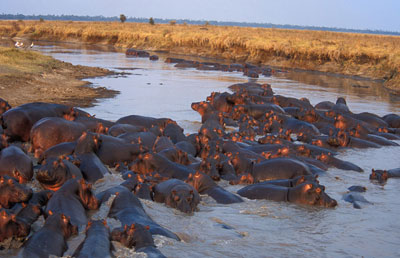
Katavi National Park
The third largest national park in Tanzania, Katavi offers wildlife in abundance. It boasts Tanzania's greatest concentration of Buffalo and Hippopotamus. Huge herds of Elephants, Roan Antelope, Topi, Zebras, Impalas, Eland, Waterbuck and more, make Katavi a haven for predators like Lion, Leopard, Cheetah and Wild Dogs. Birdlife at Lake Katavi, particularly in the wet season, is also abundant and includes Plovers, Sand grouse and the Spurring wing Goose.
Named after a legendary hunter called “Katabi”. Katavi was established in 1974, and is one of the most remote, vast, natural and pristine parks in Africa. It is located in southwest Tanzania, east of Lake Tanganyika in the Mpanda district, Rukwa region.
The landscape is dominated by two seasonal lakes called Katavi and Chada, along with miombo woodland, grass plains to the north and riverine vegetation. Mlele escarpment and the waterfalls of Chorangwa, Lukima and Ndido.
The rainfall pattern is bimodal, with short rains in November and December, and longer rains in March through May. The park is open throughout the year but is best to visit in May and October, and mid December to February.
Mahale National Park
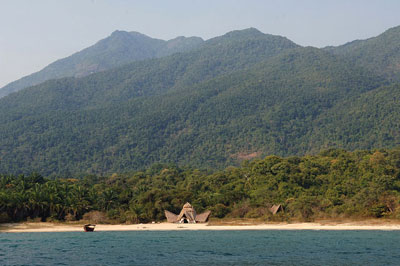
“Dreams come true. Without that possibility nature would not incite us to have them.”- John Updike.
Mahale National Park is a flourishing paradise waiting to be explored. It offers a unique combination of forests, mountains and lakes and supports an amazingly diverse range of fauna. Leopard, warthog, giant squirrel, brush tailed porcupines along with at least nine species of primates are just some of the larger mammals to be found here. The abundant birdlife includes the Crowned Eagle, Scaly Francolin, Crested Guinea Fowl, Ross’ Turaco and the globally threatened, endemic Nkungwe Apalis. Commercial fishing is prohibited along the park's shoreline which affords protection to some 350 known fish species to be found in the lake.
Mahale National Park lies 120 km south of Kigoma and is 1,613 sq km in size with its landscape dominated by Nkungwe peak (2,462m above sea level). With 14 different vegetation zones ranging from the lakeshore to Nkungwe summit, this is one of Tanzania’s most diverse and dramatically distinctive national parks.
There are over 1000 Chimpanzees in Mahale and the ‘Mimikere’ community of about 70 individuals live in the territory surrounding our camp. This group has been studied by members of Kyoto University of Japan since 1965 and as a result the Chimpanzees are accustomed to the presence of humans. This makes any encounter both unforgettable as well as exhilarating.

